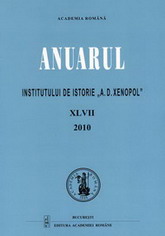O scrisoare din târgul Piatra de acum două veacuri: contribuţii la istoria oraşului
A Two-Century-Old Letter from the Town Piatra: Contributions to the Town History
Author(s): Marius ChelcuSubject(s): History
Published by: Editura Academiei Române
Keywords: Piatra town territory; Romanian urban history; modernity; rights of property
Summary/Abstract: The publication of a letter written by a princely dignitary around the year 1800 and addressed to boyar Dimitrie Bogdan, the owner of part of the Piatra town territory, represents an opportunity to make an attentive investigation on the events occurring at that time in the urban area. The whole paper relies upon a number of seventy documents, preserved in the Documents fund of the National Archives of Iasi, out of which a small part was published in a volume entitled Documents regarding the economic history of Romania, Cities and Towns. Moldavia, series A, vol. II, edited by Gh. Ungureanu, Gh. Dăscălescu, M. Gheorghiu, Gh. Robu, Bucureşti, 1960, IX + 549 p. + 6 plates. The research made on the mentioned fund of documents and by resorting to the previous contributions related to the history of that town, as well as to those studies elaborated on topics of Romanian urban history in general, is a necessary research, as it questions a number of changes occurring in the urban area at the beginnings of modernity. The old organization of the townspeople, the solidarity previously created between them, the rights they invoke in their relations to the central power and to other land owner are just a few aspects that are now submitted to modifications and raise convulsions. The prince’s renouncing the previous role of master of the town territories was not only a juridical modification, but also a practical, economic one. With the private individuals (either boyars or cult establishments) taking over the rights of property upon towns, economic advantages emerged; first of all, they started levying tithes on the cultivated lands, rents on the house and shop places, as well as taxes for the selling of goods in the permanent and periodical fairs. All of these are reactions of a society confronted with the signs of modernization, in a period when the market of Moldavia must be reassessed – in the second half of the 18th century – in relation to the impulse of growth that the economy of Central and Western Europe starts to get in the confrontation to that of the Eastern Europe and of the Ottoman Empire. Caught in this process, the townspeople of the 18th century and of the early 19th one cross a phase when the relation to the other social actors is revaluated. This revaluation follows a sinuous, insecure path, marked by the repeated invocation of the past and even by violence.
Journal: Anuarul Institutului de Istorie »A.D. Xenopol« - Iaşi
- Issue Year: XLVII/2010
- Issue No: 47
- Page Range: 263-282
- Page Count: 19
- Language: Romanian

